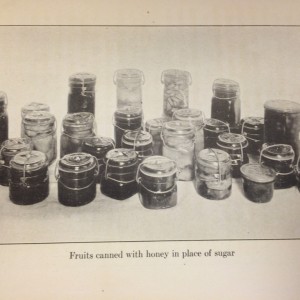This is another of the few chapters that include photos — this time of fruits canned in honey in place of sugar. Photos are printed on thicker, shinier paper which is reminiscent of card stock.

This chapter introduction brings the reader to the exact timeframe in which Mrs Andrea was producing this book — she refers to “the sugar shortage last year” on page 120, and goes on to say how she is “greatly indebted to the busy bee.” This tone of voice is exactly how somebody’s grandmother might speak when cooking with a grandchild, and is part of the book’s charm.
Mrs Andrea acknowledges that honey is more expensive than sugar, and to combat this she watered down the extracted honey to provide a lighter, more delicate flavour. She also talks of beekeeping — apparently a common pastime during the war, and suggests that sugar shortages would only be becoming more prevalent over time, which according to Mills and Rockoff, was indeed the case — rations were diminishing by up to 50 per cent and imports were becoming limited.
Mrs Andrea states that, like everything during the war, honey had gone up in price from 30 to 40 cents per pound. To a reader today, this still seems like a lot.